A First Guide to the Spiketail (Cordulegastridae)
and Cruiser (Macromiidae) Dragonflies
of Jalisco & Nayarit, Mexico
Download A First Guide to the Dragonflies of Jalisco (only)
as a FREE printable PDF
A version including Nayarit is forthcoming
 |
A contribution to the study of the biodiversity of Odonata in Jalisco & Nayarit, Mexico
This includes all species as found on Dennis R. Paulson and Enrique González Soriano's list of Mexican Odonata species which includes all those vetted on iNaturalist.com
*= go to glossary at bottom of page.
Click on links (blue text) to go to more information & other images of the species.
=!= =!= =!= =!= =!= =!= =!= =!= =!= =!= =!= =!=
|

|
Life Cycle of the Dragonfly
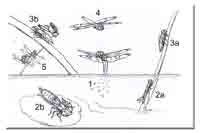
- The WEBPAGE for Jalisco (only) is also available IN SPANISH -
Para ver esta pagina web de Jalisco en espanol, haga clic aqui por favor
View an hour long webinar originally done for the Sonoma Land Trust in 2024 on the Language of the Land: Dragonflies (English) by Kathy Biggs and Sandra von-Arb
Labeled as about in California, but actually about dragonflies in general
Click here to view an  Excel Chart of the species in
Jalisco by municipality (similar to a county).
Excel Chart of the species in
Jalisco by municipality (similar to a county).
If you find a species in a new municipality, please submit it to iNaturalistor Kathy Biggs.
=!= =!= =!= =!= =!= =!= =!= =!= =!= =!= =!=
For help with identifications &/or to make a photo contribution, contact Kathy Biggs or upload it to iNaturalist
|
DRAGONFLIES (ANISOPTERA)
There are 5 families of Dragonflies (Anisoptera) represented in Jalisco & Nayarit - the Skimmers,
the Spiketails, the Cruisers, the Clubtails and the Darners.
The Spiketails and Cruisers are listed and linked to on this page.
Shortcuts to the Skimmers , Clubtails, Darners and
Damselflies of Jalisco are here.
These pages are being updated to include the species in Nayarit.
|
|
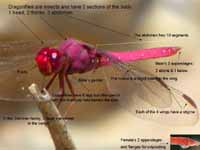
Click here to see the parts of a dragonfly's body labeled |
Within the Spiketail and Cruiser families (Cordulegastridae and Macromiidae) there are only 2 different genera represented in this region.
Spiketails (Cordulegastridae)
Of the 3 species found in Mexico, only 1 species has been documented in Jalisco and none yet in Nayarit.
Spiketails are black and yellow colored and they have tear-shaped blue eyes that barely touch each other; the thorax has two wide, yellow stripes on the top and on each side; they are found on moving water and fly beats up and down the course of the waterway.
Cruisers (Macromiidae)
Of the 2 species found in Mexico, only 1 species has been documented in Jalisco and none yet in Nayarit.
Cruisers are also black and yellow but they have gray eyes that touch each other but don't form a "seam"; they have a single yellow stripe on the thorax side; LONG legs; a body that is arched in powerful flight; they are found along rivers and large creeks.
They usually hang perch on vegetation, perpendicular to the ground.
Some of the text and MOST of the images are clickable links that will take you to more and/or larger images or maps.
Hover your mouse over them, and click if they are.
|
Common Name (Scientific Name)
photos & description
Links to maps.
|
Spiketails (Cordulegaster)
1 genera/species documented in Jalisco.
All the Spiketails are long with black and yellow coloration.
The American genus was split from the continental genus in 2024 and now is Zoraena.
=!= =!= =!= =!= =!= =!= =!=
Apache Spiketail
(Cordulegaster Zoraena diadema)
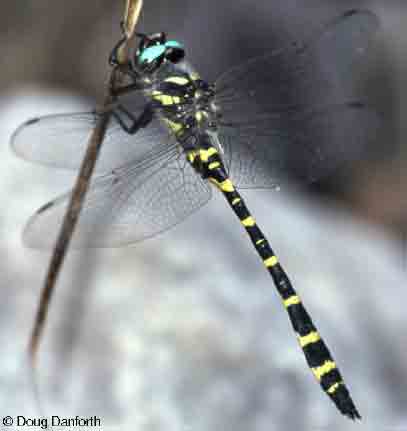 - -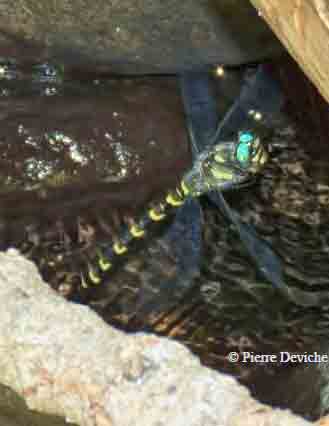
photos: male and a female *ovipositing – RARE IN JALISCO – please upload any sightings to iNaturalist
size: length 74-88 mm, wingspan 89-109 mm
male: the abdomen is dark with yellow rings, S6-8 mildly expanded; the dark thorax has 2 yellow stripes on top and on the sides; the blue-green eyes just touch at the interior points.
female: similar to the male; the long abdomen ends in a spike-like *ovipositor.
habitat: small streams, usually in the foothills.
behavior: they perch by hanging and the females *oviposit in a vertical position.
known flight months this region: months 9, 10, 12 thus far
distribution in this region: Four municipalities in Jalisco
Mexican distribution map
|
River Cruisers (Macromia)
1 genera/species documented in Jalisco.
All the River Cruisers have black coloration with yellow markings.
=!= =!= =!= =!= =!= =!= =!=
Western River Cruiser
(Macromia magnifica)
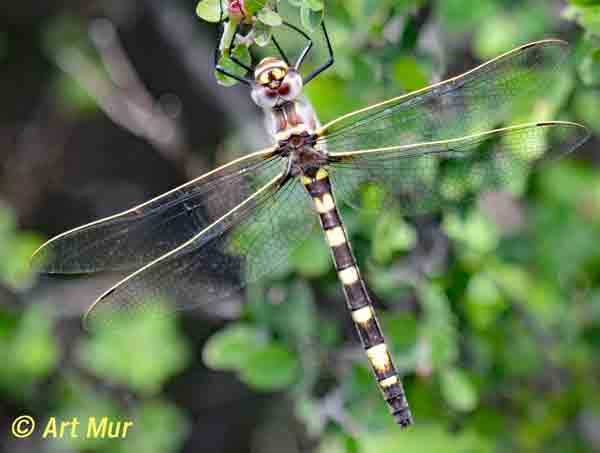
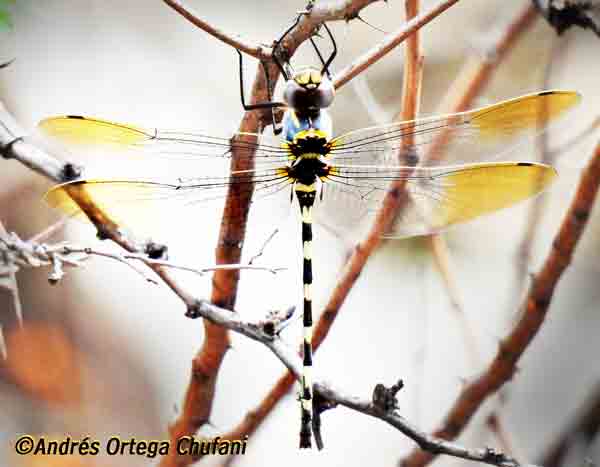
photos: scans of a live male and a live female – RARE IN JALISCO – please upload any sightings to iNaturalist
size: length 68-74 mm, wingspan 86-100 mm
male: the abdomen is black with yellow markings, the *costa of the wing is pale; pale face; pearly gray eyes touch each other; dark thorax has single yellow side stripe; only half-length stripe on top of thorax; slightly *clubbed abdomen has squared yellow spots top, segment 8 spot largest; very long legs
female: similar to the male, not *clubbed and wings can become orange-tainted from the *nodus to the outer tip as she matures
habitat: streams and rivers in lowlands
behavior: they perch by hanging and the males patrol along river shoreline with the abdomen slightly arched, usually less than a yard above the water.
known flight months this region: month 11 thus far
distribution in this region: Rio Mascota, Mascota municipality, Jalisco.
Mexican distribution map
|
Glossary:
anal loop: cluster of cells at are foot-shaped in the hind wing of some skimmers.
appendages: extensions from the tip of the abdomen. Males use theirs to grasp the female during mating; unique shape for each species
cf: from the Latin "conferre," meaning "to compare," used in biology to represent uncertain identification but similiar to the indicated species
club: referring to the expanded abdomen end, often seen on male Clubtails and a few other species
costa: leading vein of wing
frons: the uppermost part of the "face, like our forehead, but situated below and between the eyes
crepuscular: active at dusk/dawn only
labrum: part of the "face," akin to an upper lip
nodus: indentation at midpoint of wing
ovipositor/oviposit: structure for egg laying near the end of the female's abdomen/act of laying eggs
pruinose/pruinosity: waxy coating a dragonfly can secrete to cover its original coloration, like the waxy coating on a plum
S(1-10): segment on abdomen, with S1 nearest the head
stigma: small thickened area on leading edge of each wing, sometimes colored
To proceed to the page with the Darner or Clubtail page, click here (Not made for the additional species that are in Nayarit yet),
the Damselfly suborder (Zygoptera) page Damselflies, click here (Not made for the additional species that are in Nayarit yet)
To return to the page about the Skimmers in Jalisco and Nayarit, click here
Please report sightings of new or rare species or questions to Kathy Biggs
or upload to iNaturalist.org
Return to the opening page for Jalisco & Nayarit Odonata
Go to an opening page about Mexican Dragonflies,



 Excel Chart of the species in
Jalisco by municipality
Excel Chart of the species in
Jalisco by municipality 



